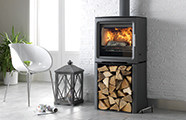The advent of clean combustion and air washes to keep the glass panel clean means wood burners perform better than ever. It is often said that nothing beats the effect of a real fire, so if you picture winter evenings snuggled up with a loved one in front of the fire then it is best achieved with a wood burning stove.

A stove can be free standing on its own or fit into an inglenook, it can be inset or chambered in a traditional or modern Adam style fireplace or it can be fitted hole-in-the-wall. Wood burning stoves use renewable energy from managed woodland and are the ‘green’ alternative compared to gas or electric fuel; this is reflected in the SAP contribution to your home which is very positive.
Wood Burner Stove Ventilation:
Ventilation is required in new-build solid fuel installations, which can seem counter intuitive when dealing with air tight new designs.
However innovations in outside air connections are becoming available to take care of this. However, investigate to ensure that the stove will have a proper air connection to its body air intake, and that the air intake also feeds into the room, when the stove is being re-fuelled to reduce any unwanted smoke spillage at this point in the burn cycle.
If you desire a longer burning real fire then solid mineral fuels do offer an alternative on multi-fuel equipped appliances but the carbon emissions from coal fuels are usually fossil, the exception being some new formulations incorporating up to 50% renewable biomass.
A multi-fuel equipped stove therefore does not offer the SAP advantages of a wood only unit because it can also be used with fossil fuels. Some perceived downsides of wood burning are the space needed to store and season logs and the fact that it creates some ash which does need cleaning out from time to time.
If you choose wisely emissions need not be smoky as was once inescapable with wood and solid fuel burners.

DEFRA:
DEFRA wood burning exemption for smokeless zones is something that can demonstrate a stove’s combustion and emissions are managed well. As an example all of Fireline’s 5kW and above stoves are DEFRA exempt and as a result, even when not fitted with the DEFRA air-control stops, they meet the requirements just as long as a flame is kept visible above the wood.
Overnight burning of any stove with wood is best avoided if you want to be kind to the environment, stick to smokeless fuels, which will do it without smoke and smouldering or just re-light in the morning with wood, which is easy when you’ve done it a few times. Generally the benefits strongly outweigh the disadvantages of wood burning in most people’s minds.
Wood Pellet Stoves:
Wood pellet stoves are gradually gaining acceptance in the UK – although much more popular in Europe, and can ignite and operate automatically and thermostatically with electronic controls. They do burn very cleanly and are convenient to use. Downsides are that they are expensive and do not have a decent flame picture combined with reliance on mains electricity supplies, which render them unusable use in a mains power outage.
If you want a great flame to look at but don’t want the effort involved in wood burning then a gas fire is the best option.
There are many gas fires now on the market that offer very realistic flame effects and log/coal fuel beds and provide an instantly controllable flame and require relatively little attention. Gas fire controls are usually battery operated full sequence remote for larger feature fires as you would expect, and more conventional manual or slide controls are available on many smaller models. Look for a remote control that can operate with thermostatic modulation if you wish to make the most of your fuel.
For more information on wood burner stoves please contact us.








